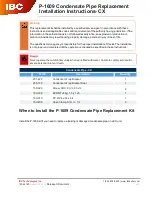
93
Flashing red led,
communication fault
with “Logica Remote Control”
Green led off if
power is cut-off
Flashing red led, water
pressure is too low (*)
Flashing red led, heating sensor fault (SM)
Flashing red led,
plant safety
valve tripped (*)
Red led on, ignition blocked:
rotate selector CR/OFF/EST/INV/RESET
to release position (
)
to restore operation
Flashing red led, safety stat tripped.
Rotate selector CR/OFF/EST/INV/RESET
to release position (
)
to restore operation
Flashing red led, fan/air pressure switch. 30 minutes after the fan has switched off,
the board will attempt a restart. In installations in sequence/cascade, in order to identify
the unit in which the fault has occurred, turn the selector in each individual boiler
CR/OFF/INV/RELEASE to the (
) [*] position and check on which boiler the flashing red
fault signal appears.
(*) When all
0.5 to 2.5 bar
leds are off, check the water pressure transducer
connection.
Fig. 19
Flashing red led, flame detection circuit fault
3.1
ELECTRONIC BOARD
The electronic boards are manufactured in
compliance with the EEC 73/23 low-voltage
directives. They are supplied with 230V and,
through a built-in transformer, send a volta-
ge of 24V to the following components: gas
valve, safety stat, C.H. sensor, external tem-
perature sensor (optional), modulator, flow
switch safety valve, water pressure tran-
sducer, water pressure switch, room stat
or “Logica Remote Control”.
An automatic and continuous modulation
system enables the boiler to adjust the heat
output to the various system requirements
or the User’s needs. The electronic compo-
nents are guaranteed against a temperatu-
re range of 0 to +60°C.
3.1.1
Fault finding
The indicator leds signalling irregular
and/or incorrect operation of the equip-
ment are indicated in fig. 19.
3.1.2
Devices
–
“POT. RISC.” trimmer
(10 fig. 20)
Sets the maximum heating power value.
To increase the value turn the trimmer
clockwise; to reduce the value turn the
trimmer anticlockwise.
–
“POT. ACC.” trimmer
(6 fig. 20)
Trimmer to vary the pressure level upon
ignition (STEP), of the gas valve.
According to the type of gas for which
the boiler is equipped, the trimmer must
be regulated so as to obtain a pressure
of approx. 3 mbar at the burner for
methane gas and 7 mbar for propane
gas (G31). To increase pressure, turn
the trimmer clockwise; to reduce pres-
sure, turn the trimmer counterclockwi-
se. The slow ignition pressure level can
be set during the first 3 seconds fol-
lowing burner ignition.
After setting the pressure level upon
ignition (STEP) according to the type of
gas, check that the pressure for hea-
ting is still at the value previously set.
–
“MET-GPL” connector
(7 fig. 20)
When the connector
is not connected
up the boiler is ready to operate on
METHANE; when the connector
is con-
nected
up the boiler is ready to operate
on PROPANE.
–
“ANN. RIT.” connector
(5 fig. 20)
In the heating phase, the electronic board
is programmed to include a burner tech-
nical delay interval of approx. 90 seconds,
which occurs both at system cold star-
ting and at subsequent re-ignitions. The
aim is to overcome the problem of repea-
ted ignitions and turning of f with very
short time intervals between. This could
occur in particular in systems presenting
high head losses. At each restart after
the period of slow ignition, the boiler will
set itself for about 1 minute at the mini-
mum modulation pressure, and will then
move to the heating pressure value set.
When the connecting link is inser ted,
both the programmed technical pause
and the period of operation at minimum
pressure in the startup phase will be can-
celled. In this case, the times elapsing
between turning off and subsequent re-
ignition will depend on a temperature dif-
ference of 5°C detected by the SM sen-
sor (heating flow sensor).
–
“Albatros” connector
(15 fig. 20)
In single installations, the connector is
disconnected. Where multiple boilers
are installed in a sequence/cascade, the
connector is used for connection with
regulator RVA47.320.
ATTENTION: It is essential that the opera-
tions described above be carried out by
authorized technical staff.
3.2
TEMPERATURE SENSOR
AND WATER PRESSURE
TRANSDUCER
Tables 3 - 3/a
show the resistance values
(
Ω
) that are obtained on the sensor as the
temperature varies and the transducer
values obtained as the pressure varies.
When the sensor (SM) is disabled, the boi-
ler will not work.
3
CHARACTERISTICS
TABLE 3 (Sensor)
Temperature (°C)
Resistance (
Ω
)
20
12.090
30
8.313
40
5.828
50
4.161
60
3.021
70
2.229
80
1.669












































